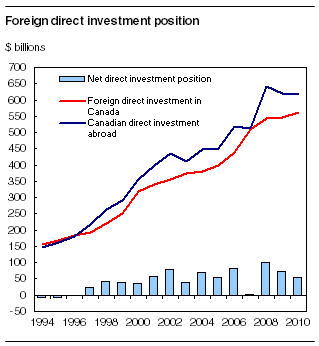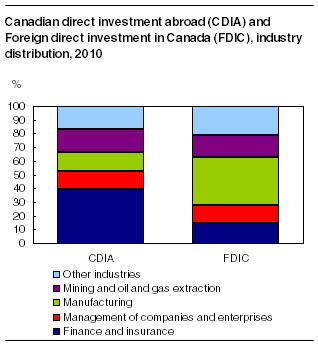Foreign direct investment
Archived Content
Information identified as archived is provided for reference, research or recordkeeping purposes. It is not subject to the Government of Canada Web Standards and has not been altered or updated since it was archived. Please "contact us" to request a format other than those available.
Related subjects
-
[an error occurred while processing this directive]
Canadian direct investment assets abroad declined in value for a second consecutive year in 2010, largely as a result of the revaluation effect of an appreciating Canadian dollar. These assets were down $4.5 billion to $616.7 billion. Foreign direct investment in Canada increased further, led by investment from the United States. Direct investment in Canada was up $14.0 billion to $561.6 billion. As a result, the net direct investment asset position narrowed further to $55.1 billion in 2010.

Canadian direct investment abroad pulled down by appreciating Canadian currency
The Canadian dollar appreciated against most foreign currencies in 2010, in particular the US dollar, the Euro and the British pound. This resulted in a decrease in the value of Canadian direct investment abroad, despite strong investment in existing affiliates and mergers and acquisition activity during the year. The overall valuation effect of an appreciating Canadian dollar on these foreign currency denominated assets was a decline of $35.5 billion.
Note to readers
This is the annual release of detailed foreign direct investment data. This release contains country detail for direct investment that is drawn from the annual survey. This information was not available at the time of the quarterly International Investment Position release.
Direct investment is a component of the international investment position that refers to investment of a resident entity in one country obtaining a lasting interest in an enterprise resident in another country. The lasting interest implies the existence of a long-term relationship between the direct investor and the enterprise and a significant degree of influence by the investor on the management of the enterprise.
In practice, direct investment is deemed to occur when a company owns at least 10% of the voting equity in a foreign enterprise. This report presents the cumulative year-end positions for direct investment. In the Canadian statistics, direct investment is measured as the total value of equity, net long-term claims and net short-term claims held by the enterprise across the border.
Foreign direct investment is often channeled through intermediate holding companies or other legal entities before reaching its ultimate destination. Since these entities are generally in the financial sector, this sector accounts for a larger share on an immediate investor basis than if the ultimate destination were known. This is especially the case for Canadian direct investment abroad.
Currency valuation
The value of direct investment abroad is denominated in foreign currency and converted to Canadian dollars at the end of each period for which a year-end position is calculated. When the Canadian dollar is appreciating in value, the restatement of the value of direct investment abroad in Canadian dollars decreases the recorded value. The opposite is true when the dollar is depreciating. Foreign direct investment in Canada is directly recorded in Canadian dollar and the fluctuation of the Canadian dollar has no impact on the recorded value.
In 2010, the Canadian dollar gained ground (+5.7%) against the US dollar. It also appreciated by 13.0% against the euro and 9.5% against the British pound. However, it depreciated by 7.9% against the Japanese yen.
Lower Canadian direct investment across a number of countries
Canadian direct investment edged down to $249.9 billion in the United States by the end 2010. In the United Kingdom, it declined to $70.2 billion from a high of $73.4 billion in 2009. Canadian direct investment in all other countries was also down slightly to $296.6 billion, although this reflected a mix of increases and decreases across countries.
The US share of total direct investment abroad remained at 40.5% in 2010, while the United Kingdom accounted for 11.4%. The share of total direct investment in the United States and the United Kingdom has been trending downward for several years. Meanwhile, Canadian direct investment in Brazil, Russia, India and especially China (BRIC countries), as well as investments in the Caribbean, have been on an uptrend for most of the last 10 years.
Foreign direct investment from the United States on the rise
Foreign direct investment in Canada rose by 2.6% in 2010, led by stronger investment flows from the United States. Canada's direct investment liability to the United States was up 5.0% to $306.1 billion in 2010. Direct investment from all other countries combined fell 0.3% in 2010 to $255.5 billion.
Geographical share of foreign direct investment in Canada continues to evolve
The share of direct investment in Canada held by American investors was up for the first time since 2004, rising to 54.5%. The Netherlands was the second largest direct investor in Canada in 2010, a rank that it has maintained since 2008. The Netherlands represented 9.2% of the total direct investment in Canada in 2010, followed by the United Kingdom (7.5%), Switzerland (3.6%) and France (3.4%).
Over the longer term, however, the US share of foreign direct investment in Canada has declined, falling from 64.6% in 2001 to 54.5% in 2010. Conversely, over the past 10 years, the share of the "Asia/Oceania" region has grown from 4.5% in 2001 to 11.2% in 2010. Much of the gain from this region came from China. Further, the share of the "Other America" region has grown from 0.3% in 2001 to 2.7% in 2010.
Canadian direct investment abroad dominated by financial-management industries
In 2010, 52.4% of Canadian direct investment abroad was directed to finance, insurance and management industries, compared with 38.1% in 2001. The mining and oil and gas industry also increased its share of investment abroad during the same period, rising from 11.8% to 17.1%. As these industries were growing in importance, manufacturing's share fell from 26.7% in 2001 to 14.1% in 2010.

Foreign direct investment in Canada largely accounted for in manufacturing
Manufacturing remains the top industry for direct investment in Canada at 34.8% in 2010. However, its share of the total has fallen from 42.9% in 2001. On the other hand, the share of the mining, oil and gas industry has grown from 12.8% in 2001 to 16.4% in 2010.
Available on CANSIM: tables 376-0038 and 376-0051 to 376-0054.
Definitions, data sources and methods: survey number 1537.
For more information, or to order data, contact Client Services (613-951-1855; infobalance@statcan.gc.ca). To enquire about the methods, concepts or data quality of this release please contact Christian Lajule (613-951-2062; christian.lajule@statcan.gc.ca) or Marie-Josée Lamontagne (613-951-5179; marie-josee.lamontagne@statcan.gc.ca), Balance of Payments Division.
- Date modified:
